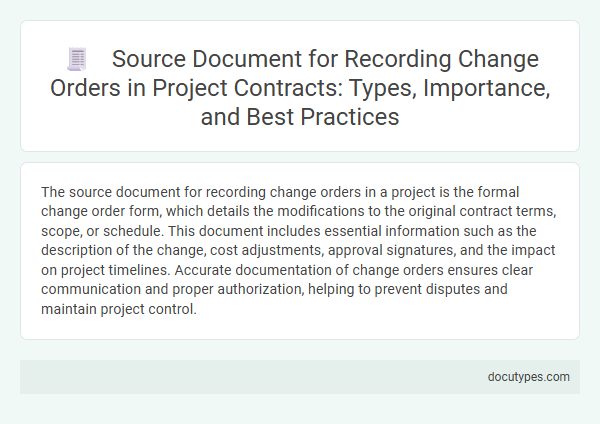The source document for recording change orders in a project is the formal change order form, which details the modifications to the original contract terms, scope, or schedule. This document includes essential information such as the description of the change, cost adjustments, approval signatures, and the impact on project timelines. Accurate documentation of change orders ensures clear communication and proper authorization, helping to prevent disputes and maintain project control.
Introduction to Change Orders in Project Contracts
Change orders are essential documents in project contracts that capture modifications to the original scope, timeline, or cost. They ensure that any adjustments agreed upon by the parties are formally recorded and authorized.
The source document for recording change orders is typically the Change Order Form or Change Order Request. Your project management system or contract repository usually contains these documents for tracking and approval purposes.
Defining Source Documents for Change Orders
The source document for recording change orders in a project is the official change order form or change request document. This document details modifications to the original contract, including scope, cost, and schedule adjustments. You rely on these source documents to ensure accurate and authorized updates to the project records.
Types of Source Documents Used for Change Orders
Source documents for recording change orders in a project are essential for maintaining accurate project records and ensuring accountability. These documents capture the details and approvals necessary to authorize modifications to the original contract scope or terms.
Common types of source documents used for change orders include change request forms, which outline the proposed modifications and their impact on cost and schedule. Approved change order agreements serve as formal confirmation between parties involved. Supporting documents such as emails, meeting minutes, and cost estimates provide additional context and justification for the changes.
Key Components of Effective Change Order Documentation
What is the source document for recording change orders in a project? The source document is typically the approved change order form issued during the project's change management process. This form captures the scope, cost, and timeline adjustments authorized by all relevant stakeholders.
What are the key components of effective change order documentation? Effective documentation must include a clear description of the change, justification for the modification, detailed cost impact, and approvals from project managers and clients. Accurate documentation ensures transparency, accountability, and prevents disputes during project execution.
Importance of Proper Source Document Management
The source document for recording change orders in a project is typically the approved change order form or change request form. This document provides detailed information about the scope, cost, and schedule adjustments agreed upon by all parties involved.
Proper source document management ensures accurate tracking of project changes and prevents disputes over contract modifications. Maintaining organized records supports transparency and accountability throughout the project lifecycle.
Legal Implications of Change Order Source Documents
Source documents for recording change orders in a project serve as the foundational evidence for alterations in contract scope, cost, and timeline. Understanding their legal implications is essential to ensure enforceability and prevent disputes.
- Contract Amendments - Formal modifications signed by all parties that legally alter original contract terms.
- Change Order Requests - Written requests detailing the proposed changes, serving as preliminary evidence for approval processes.
- Approval Signatures - Authorized signatures that confirm mutual consent and establish legal validity of the change order.
Proper documentation and compliance with contract terms in change order source documents minimize legal risks and support enforceable project changes.
Standard Procedures for Recording Change Orders
| Aspect | Details |
|---|---|
| Source Document | Change Order Form or Change Order Request |
| Description | Official document used to request, authorize, and record modifications to the original project contract scope, cost, or schedule. |
| Standard Procedures |
|
| Importance for Your Project | Accurate recording via the standardized Change Order Form helps prevent disputes, maintains project control, and ensures financial accountability. |
Best Practices for Documenting Change Orders
The source document for recording change orders in a project is typically the official Change Order Form or Change Request Document. Accurate documentation is essential to track modifications and ensure project scope, schedule, and costs are properly managed.
Best practices for documenting change orders include clear descriptions, authorization signatures, and maintaining chronological records.
- Use Standardized Change Order Forms - Standard forms ensure consistency in capturing all necessary details such as scope changes, cost impacts, and schedule adjustments.
- Obtain Written Approvals - Signed authorizations from relevant stakeholders validate the change and prevent disputes.
- Maintain a Centralized Change Log - A comprehensive log helps you monitor all changes and provides an audit trail for the entire project.
Common Challenges in Managing Change Order Documents
The source document for recording change orders in a project is typically the change order form or change order request submitted by the contractor or project manager. This document officially records modifications to the original contract scope, cost, or timeline and serves as the primary reference for approval and implementation.
Managing change order documents involves several common challenges that can impact project accuracy and efficiency.
- Lack of Standardization - Inconsistent formats and incomplete details in change order documents lead to miscommunication and delays.
- Poor Document Tracking - Failure to maintain updated records hinders visibility on pending approvals and impacts project scheduling.
- Approval Bottlenecks - Delays in stakeholder review and authorization slow down project progress and increase costs.
What Is the Source Document for Recording Change Orders in a Project? Infographic

